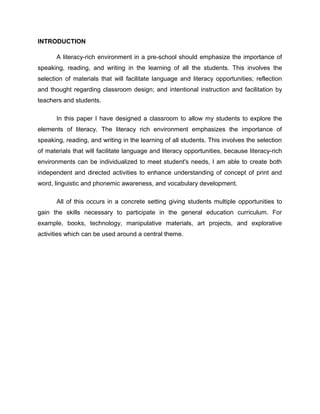
Literacy rich environment
- 1. INTRODUCTION A literacy-rich environment in a pre-school should emphasize the importance of speaking, reading, and writing in the learning of all the students. This involves the selection of materials that will facilitate language and literacy opportunities; reflection and thought regarding classroom design; and intentional instruction and facilitation by teachers and students. In this paper I have designed a classroom to allow my students to explore the elements of literacy. The literacy rich environment emphasizes the importance of speaking, reading, and writing in the learning of all students. This involves the selection of materials that will facilitate language and literacy opportunities, because literacy-rich environments can be individualized to meet student's needs, I am able to create both independent and directed activities to enhance understanding of concept of print and word, linguistic and phonemic awareness, and vocabulary development. All of this occurs in a concrete setting giving students multiple opportunities to gain the skills necessary to participate in the general education curriculum. For example, books, technology, manipulative materials, art projects, and explorative activities which can be used around a central theme.
- 2. LITERATURE REVIEW Reading in the EFL classroom takes many forms, but is often used as a way of introducing grammar or vocabulary items. The ‘teaching’ of reading has found its way into many classes, but often just in terms of teaching (or practicing) techniques such as skimming and scanning. In some classes students are asked to read out loud, turning what is fundamentally a private receptive activity into a more public and production- orientated activity. This type of reading is often decried as not being realistic. However, that isn’t really the case as there are often instances in real life when we read things out to each other (bedtime reading to children, reading a short article out at the breakfast table, reading a menu at a restaurant – for example, when we find something interesting or when we want to discuss what we might eat or drink). Another thing we must remember is that many people claim that they do not read much in their own language. In fact this isn’t really the case. It’s simply that most people equate reading with reading novels and long texts, whereas we spend a lot of time reading in our L1 (first language) – we read instructions, recipes, messages (especially text messages), emails, information about what’s on TV, etc. So, for whatever reason and in whatever way we ‘do’ reading in the class, reading is not uncommon. But what exactly is reading At the most basic level reading is the recognition of words. From simple recognition of the individual letters and how these letters form a particular word to what each word means not just on an individual level, but as part of a text. In English, as in many other languages, different combinations of the same letters can be used to form different words with completely different meanings. Recognition of the actual word is not enough on its own to constitute reading. Understanding what we are reading is the key and is certainly the main point of teaching reading in a class. It’s not much good if our students simply stare at a text. Understanding a text is quite a complex issue.
- 3. There are a number of reasons why we read and this will often influence what we read and how we read it. We might read for pleasure. In this case it is most likely that we will be reading a book of some sort, maybe a novel, or perhaps a poem. We could also be reading the lyrics to a song and our reasons for reading it may be slightly more complex than simply for pleasure. We could be reading it because we have heard the song, but didn’t quite catch the words. In other words, there might be multiple reasons why someone might read a text. But working out the purpose is a key factor when it comes to teaching reading. Why we are reading something will make a difference to how we read it, and in what depth. We must also bear in mind the purpose of the text from the writer’s point of view. Somebody wrote the text and they had a reason for doing so. It could be that the writer’s and the reader’s reasons are the same, or similar. But it is equally possible that the two have different purposes. The writer has a message they want to convey and they encode this message in the words and style they choose. The reader then tries to decode the message by reading the same words. This encoding and decoding doesn’t simply exist on the level of meaning, but also on the level of why the text was written. At first glance the question seems rather silly. Of course reading isn’t different, whatever language you are reading in. The text might be written using a different alphabet or characters, it might be written from right to left, or bottom to top, but fundamentally the same processes are going on. Well, at one level this is certainly true, but it may well be that we are not really conscious or aware of how we are reading in our own language. Reading was a skill we developed as we grew up and as we became acquainted with different types of text. Once we start seeing these texts in a foreign language we are unable to decode the message. The problem is probably not that we are not using the correct techniques, but that we are unable to recognize the words and meaning. This causes us a big problem. The problem is that we begin to panic. We start to try and use different techniques and strategies to understand the text. We start to read every word in a way that we wouldn’t
